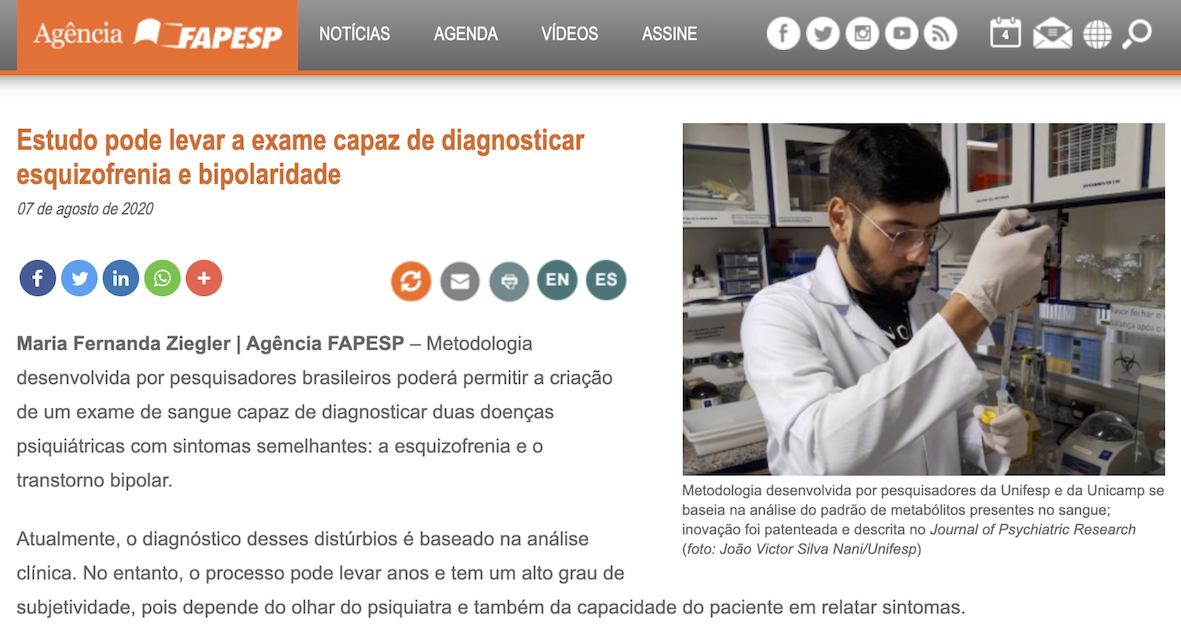
Currently, the diagnosis of these disorders is based on clinical analysis. However, the process can take years and has a high degree of subjectivity, as it depends on the psychiatrist's interpretation and also on the patient's ability to report symptoms.
The laboratory exam, developed by researchers at Universidade Federal de São Paulo (Unifesp) and Universidade Estadual de Campinas (Unicamp), is the first capable of differentiating these two disorders through the analysis of biochemical and molecular changes involved in pathologies. The innovation, already patented, was described in the Journal of Psychiatric Research.
“It is complicated to differentiate two diseases that share similar symptoms through clinical examinations. With the laboratory exam it is possible to identify patterns in the blood serum and, thus, differentiate between schizophrenia and bipolar cases in a precise way, which improves the prognosis of the patients ”, says Mirian Hayashi, professor at the Pharmacology Department at Escola Paulista de Medicina (EPM -Unifesp) and coordinator of the study supported by FAPESP.
The researchers say that the great advantage of the method is in analyzing the pattern of metabolites present in the blood - a set of chemicals resulting from reactions of the metabolism - and not a specific biomarker such as proteins, genes or other molecules. It is estimated that there are more than 2 million metabolites in the blood serum.
In previous studies, the group had already differentiated patients with schizophrenia from healthy people, as well as bipolar patients from healthy people.
The researchers also looked at crack users, because the drug mimics the first psychotic episode of patients with schizophrenia. “If the individual does not report that he is a crack user, he may be mistaken for a patient with schizophrenia in the first psychotic episode. In our study, however, perhaps because it is a fleeting molecular effect, we were unable to differentiate drug users from healthy individuals who are not users, ”says Hayashi.
The differentiation between cases of bipolar disorder and schizophrenia is the result of the second stage of the research project, when the metabolite patterns were already well established. To prove that it is possible to distinguish the two disorders by biochemical techniques, blood serum samples from 182 individuals were analyzed, including schizophrenic, bipolar patients and a control group composed of healthy people.
As in previous studies, the analysis of the metabolomic profile of patient serum samples was carried out at Unicamp's Chemistry Institute, under the coordination of Professor Ljubica Tasic and with support from FAPESP. The researchers associated the hydrogen proton nuclear magnetic resonance technique with chemometry (statistical approach to chemical analyzes).
“Our goal was to find different patterns of metabolites and associate them with one of the disorders. For this, we put the blood serum samples under the effect of a magnetic field. With the analysis of proton nuclear magnetic resonance it is possible to detect all variations (peaks) of protons in a sample. As every molecule has protons, it is possible to draw a resonance profile, with different compositions within a fluid. When analyzing these proton variations between different individuals, it is possible to identify patterns in the samples of schizophrenic patients that differ from the patterns in bipolar or healthy people ”, reports Hayashi.
“The study not only differentiates one condition from the other, it also brings new information about the disorders, which can be studied in the future. After all, if there is a pattern of alteration in metabolites, it results from a specific pathway for each disease, which we still do not know about, ”says João Victor Silva Nani, FAPESP grantee and co-author of the article.
The discovery of molecular pathways related to schizophrenia and bipolar disorder may, in the future, contribute to the development of new, more efficient treatments. With this perspective in mind, the group also started a project in collaboration with Japanese researchers, which may receive funding from the Japanese government.
According to Hayashi, the most accepted hypothesis by science for cases of schizophrenia and bipolarity is associated with the imbalance of dopamine (neurotransmitter in the brain), so much so that the main antipsychotics are dopamine modulators.
“It is known that the use of illicit drugs such as crack momentarily promotes the imbalance of this neurotransmitter, increasing the release of dopamine. Therefore, crack users in crisis have similar symptoms. However, people with schizophrenia or bipolarity also have genetic changes in addition to the chemical imbalance in the brain. For this reason, we also study crack users, ” she says.
Through bioinformatics and artificial intelligence techniques, the team formed by Brazilian and Japanese researchers intends to identify the pathways involved in these diseases. “Although the underlying genetic reasons that lead the individual to be schizophrenic or bipolar are recognized, these are genes common to several mental disorders. By identifying these unique metabolic pathways for each disease, it will be possible, in the future, to improve treatment ”, she says. But the researchers also recognize that many studies and projects are still needed so that they can effectively employ this in the clinic and really help these patients.

